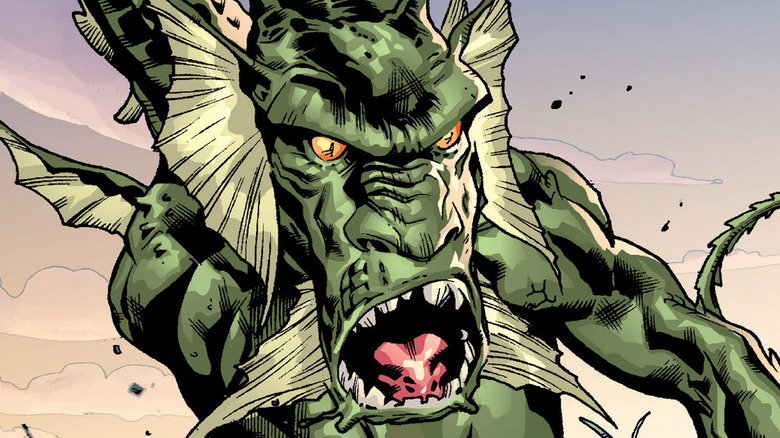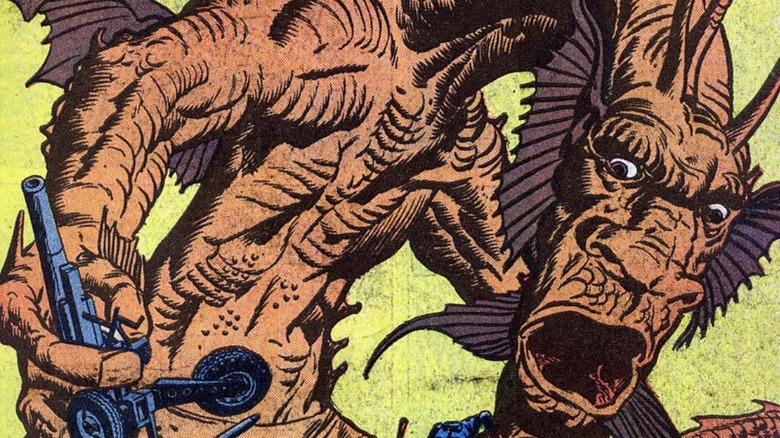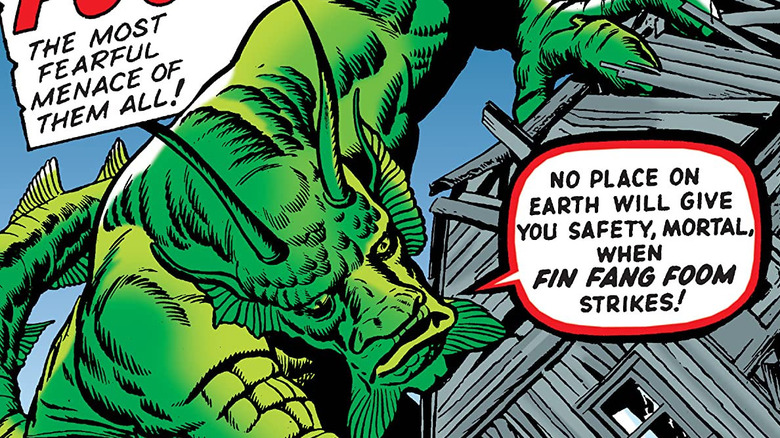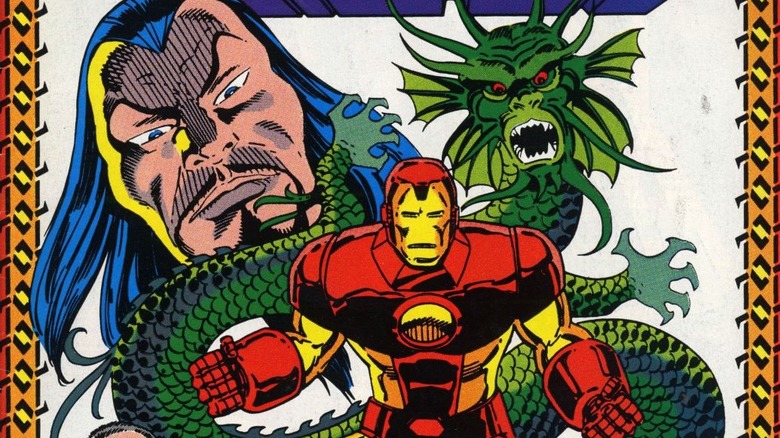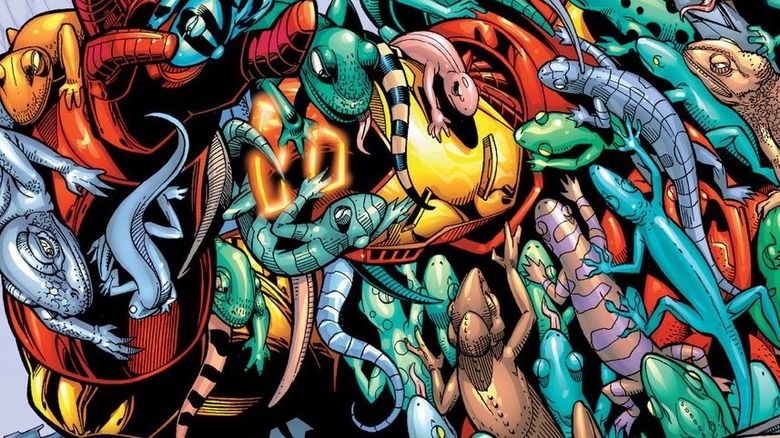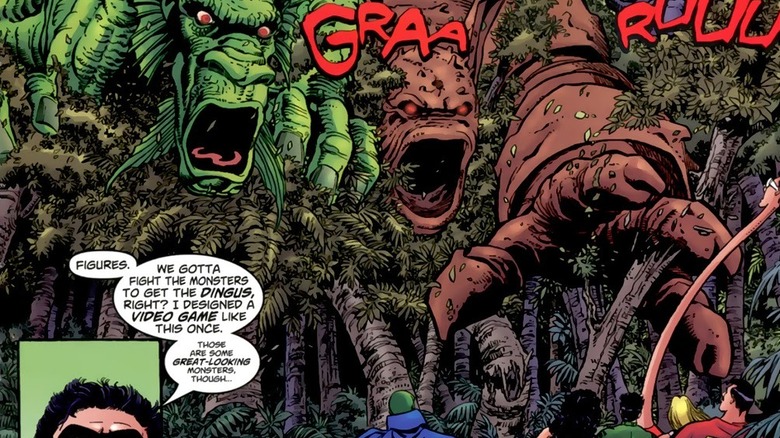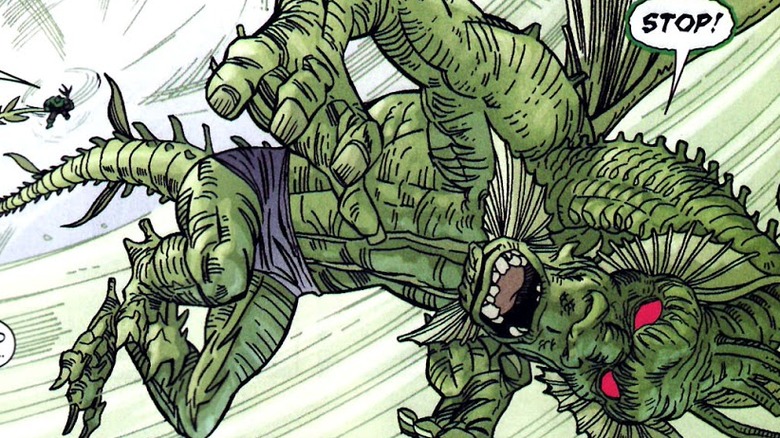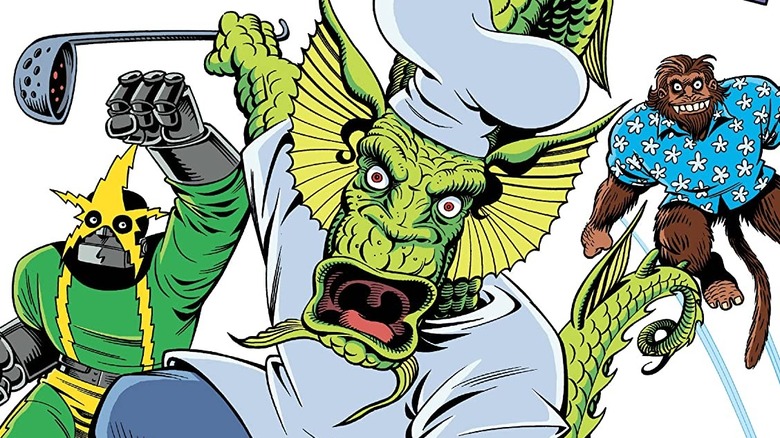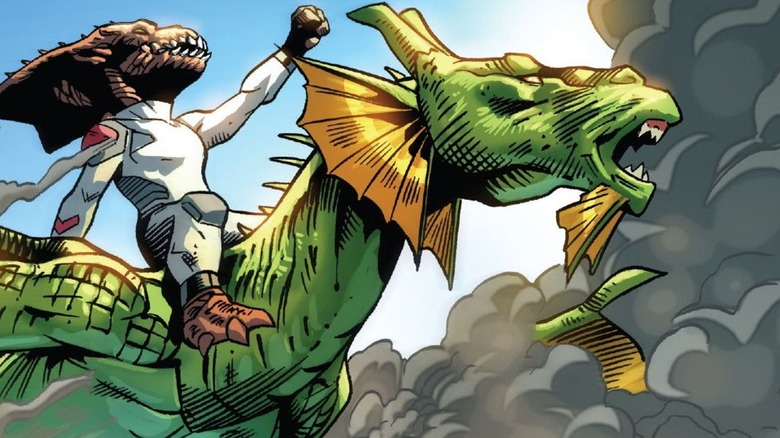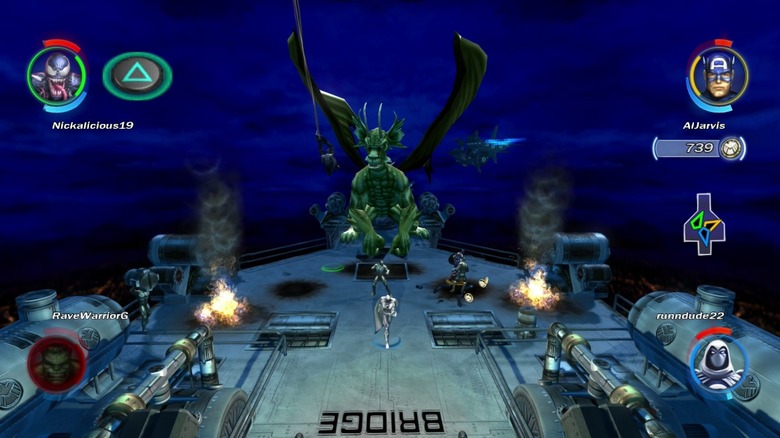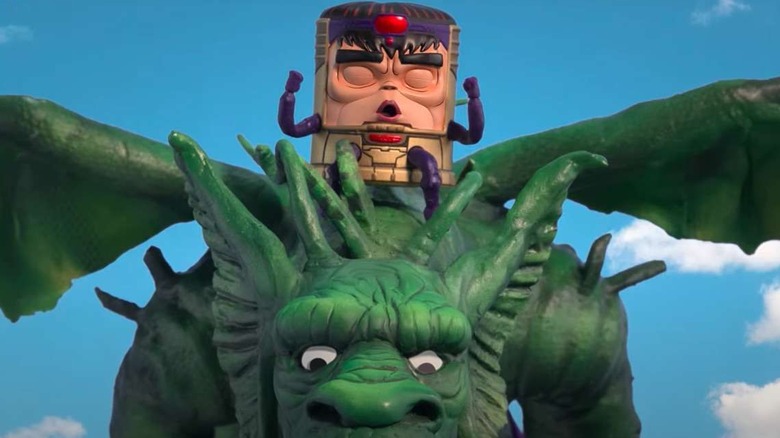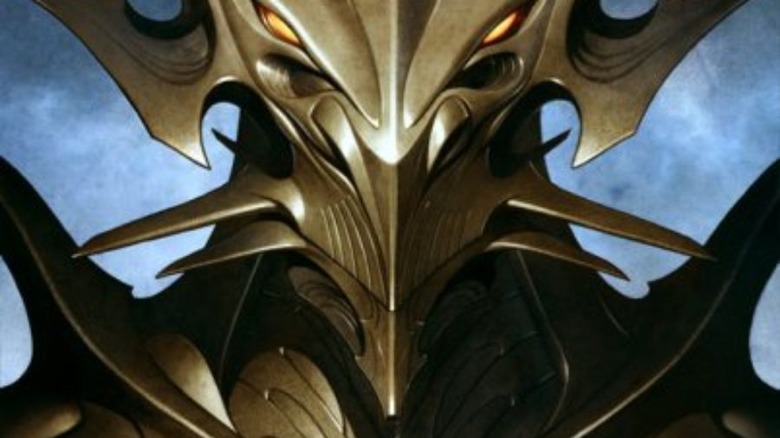The History Of Marvel's Fin Fang Foom Explained
After trailers for 2021's "Shang-Chi and the Legend of the Ten Rings" started making the rounds, some folks saw its brief underwater shot of a dragon and jumped to the conclusion that they were looking at Fin Fang Foom, the venerable Marvel monster. Then a June 2021 interview NBC conducted with Simu Liu, who plays the titular butt-kicker in "Shang-Chi," revealed that the "shape-shifting dragon-like being puzzlingly named 'Fin Fang Foom'" would not be making it to the big screen.
Considering how Marvel has handed Asian representation in prior film and TV projects, it's probably for the best that they decided against including the extraterrestrial shapeshifter and made-up Chinese folk legend. But just because Fin Fang Foom isn't in "Shang-Chi" doesn't mean the interstellar baddie isn't worth discussing. After all, he's a talking dragon from outer space who fights superheroes — that is, when he isn't pursuing Buddhism or his career as a celebrated chef. This is the totally nuts and deeply entertaining history of Marvel's Fin Fang Foom.
In the beginning, Fin Fang Foom was a sleepy space dragon
Like "Guardians of the Galaxy" comedy kingpin Groot, Fin Fang Foom originates from the early, pre-Fantastic Four 1960s, when Marvel still considered itself a monster comics publisher. According to the bio provided by Marvel.com, Triple F was born and raised on a distant planet called Kakaranathara, commonly referred to as Maklu IV. In defiance of his home world's anti-war philosophy, Fin Fang Foom ultimately arrives on Earth with a handful of other Makluans, full of imperial intentions.
After an encounter with ancient Chinese warriors ends in disappointment, however, most of the invading space dragons disguise themselves as humans to blend in with the population. It is determined that Fin Fang Foom should stay behind and remain hidden in a mountain, in case any of his compatriots require his assistance at a later date. Deciding this plan sounds reasonable, Fin Fang Foom consumes a mysterious Makluan herb and hibernates for hundreds of years. Meanwhile, the rest of the space dragons integrate into human society.
When we think about the most imposing and dangerous extraterrestrial races in Marvel, we think of the Skrulls, the Kree, the Shi'ar, and a few others. The Makluans don't usually make the list, despite the fact that they're terrifying to behold, super-intelligent, and out to conquer the planet. Fin Fang Foom's comrades blended in too well, apparently.
Fin Fang Foom made his debut in 1961
With the ambitions of the Makluan invaders largely washed into the ocean of time, Fin Fang Foom — whose name roughly translates to Earthling English as "He Whose Limbs Shatter Mountains and Whose Back Scrapes the Sun" — is left to sleep in a mountain somewhere in rural China pretty much indefinitely. At one point, he wakes up and causes just enough commotion to inspire worshipful mass devotion and the formation of a new alternative religion. Then he goes back to bed. Devotees proceed to watch over his cave of cozy slumber for generations.
Finally, we arrive at the events depicted in the first appearance of Fin Fang Foom, 1961's "Strange Tales" #89, by Stan Lee, Larry Lieber, and Jack Kirby. In this inaugural story, a folklore-savvy villager awakens Fin Fang Foom and solicits the legend's help in fending off a communist militia that threatens his neighborhood. Once the anti-capitalist forces have been routed, the villager allows his scaly ally to resume naptime.
Decades passed in real time before Fin Fang Foom returned from obscurity to become one of Iron Man's most memorable foes. This speaks to the staying power of Stan Lee and Jack Kirby's 1960s creative streak: Even the ideas that initially paled in comparison to instant successes like the Fantastic Four have oodles of staying power. It took Fin Fang Foom a while to find his groove, but once he did, he became a Marvel mainstay.
Fin Fang Foom teams up with the Mandarin ... for a while
Fin Fang Foom languished in obscurity until comics heavyweights John Byrne and John Romita Jr. reintroduced him to readers in the early '90s Iron Man event, "Armor Wars II." While Tony Stark deals with personal health issues, the Mandarin returns and jostles the space dragon back into the waking world. This pair of villains proceeds to use their combined powers to take over a significant portion of Chinese territory, until they experience a falling out. Funny how bad guy team-ups always seem to end that way.
Thus, the Mandarin, a pre-War Machine James Rhodes, and Tony Stark pit their strength and smarts against Fin Fang Foom throughout the subsequent "Dragon Seed Saga." It's right around this period when we learn something crucial: The Mandarin's fabled 10 rings originated on Maklu IV, and were essential for controlling the ship Fin Fang Foom and his cohort arrived in. This detail cemented the space dragon's keystone place in the Marvel Universe forever.
Thousands of lizards come together to form Fin Fang Foom's new body
You would think that life as an immortal space dragon would be weird enough on its own. Not so for Fin Fang Foom, who apparently can't sit idle for long. Following his defeat and apparent death at the conclusion of the "Dragon Seed Saga," Marvel's second-favorite big green time bomb of rage transplants his spiritual essence into a dragon-shaped trinket, which comes into the possession of a young man in New York City. Sort of like the demon in "The Exorcist," Fin Fang Foom proceeds to take spiritual possession of this hapless rube.
From there, as depicted in 1999's "Iron Man #16," Fin Fang Foom summons a virtually infinite number of lizards lurking in the ickiest corners of the Big Apple. This tide of reptiles merges together into a gargantuan single form, creating a deeply-disturbing new physical body for Fin Fang Foom to inhabit. This body is promptly trounced by Iron Man, because of course it is — it's made of small lizards, after all. Still, the visual is unforgettable, and you can't help but admire Foomy for trying this absurd tactic out.
After this elaborate and somewhat disgusting plan ends in humiliation, Iron Man sends Fin Fang Foom to Monster Island, in the hopes that the big green dragon has learned his lesson as far as mindless rampages of destruction are concerned. But of course, he hasn't.
Fin Fang Foom fights the Justice League
Not too many Marvel characters can say they've been punched out by Superman, but Fin Fang Foom is among that number. In 2003's "JLA/Avengers," a "Crisis on Infinite Earths"-esque scenario unfolds when a mysterious inter-dimensional force erases entire universal timelines. To keep their respective worlds intact, DC Comics' Justice League of America and Marvel's Avengers embark upon quests for designated objects of power. Transported to Marvel's Earth, the JLA track down the Ultimate Nullifier on an island in the sea of Okhotsk. Before they can nab the device, however, they find themselves confronted by Fin Fang Foom and two other distinctly Kirby-ish colossi. Even as they're terrified, our heroes can't help but remark upon how darn cool these beasts look.
The ensuing battle goes very poorly for the resident monsters — after all, Fin Fang Foom is just an ordinary shape-shifting dragon-esque entity who wields normal dragonish powers like strength, flight, and fire breath. He can't compete with Kal-El of Krypton in a fist fight, and he's certainly no match for Superman plus a whole pack of A-list DC crimefighters. And yet, Fin Fang Foom has proven himself a major threat to numerous Marvel heavy-hitters over the years, including Iron Man, Thor, and the Hulk. Does that mean Marvel heroes are demonstrably less powerful — and definitely not as good at fighting space dragons — as their DC counterparts? That's one question fans will have to debate among themselves.
The Hulk throws Fin Fang Foom to the Moon
Like so many fictional threats before him, Fin Fang Foom eventually finds himself frozen in the South Pole. This frosty nap gets cut short in the 2008 mini-series "Hulk vs. Fin Fang Foom" when scientists stationed at an outpost codenamed Polar Station One notice the leviathan has gotten loose under the ice. In an uncanny coincidence, the same group finds Bruce Banner in the middle of the Antarctic right around the same time. One thing leads to another, and the next thing anyone knows, the Hulk and Fin Fang Foom are duking it out at the bottom of the Earth.
This spectacular battle comes to a stop when Fin Fang Foom tries to convince the Hulk that they'd be better off as a team — after all, they're both green, they're both angry, and boy, do they both love to smash. But the Hulk won't hear of it. Instead of forming an alliance, in fact, the Hulk tosses the Fin Fang Fella directly at the Moon, where he lands as safely as can be expected.
Fin Fang Foom retires from evil, discovers Buddhism, becomes a chef
Fighting the good guys gets tiring after a while, even if you're an immortal space dragon. You start to go through the motions, question the meaning of everything, and let your skills slacken after the first few hundred go-'rounds. So it's not surprising that Fin Fang Foom eventually takes a second glance at his destruction and domination-oriented existence and decides to venture down a new path.
With some assistance from Reed Richards, Fin Fang Foom gets his life on track, begins to practice Buddhism, cranks up his culinary game, and opens a restaurant in the Baxter Building food court. He also briefly joins forces with three other reformed monsters under the banner of the "Fin Fang Four." This remarkable transformation can be seen in 2005's "Marvel Monsters: Fin Fang Four" #1 and 2008's "Giant-Size Avengers" #1.
The change doesn't quite stick, and Fin Fang Foom eventually returns to madness and lawlessness. However, his time in the company of the Fantastic Four does appear to have lasting ramifications. Even when Fin Fang Foom commits antisocial acts in the post-Baxter Building period of his life, there's typically a misguided or understandable purpose involved. He goes from being an unambiguously evil individual to, if not quite a sympathetic figure, certainly someone who can't be blamed entirely if he behaves how society tells space dragons they're supposed to behave.
Fin Fang Foom finds inner peace
After his dalliance with cooking and calm, Fin Fang Foom goes back to terrorizing bad guys (albeit with more nuance). At one point, the alliterative space dragon is mercilessly beaten by Drax the Destroyer – in a comic penned by CM Punk, no less. This unfortunate encounter with Drax occurs during Fin Fang Foom's failed attempt to create more space dragons, which he believes might fill the hole in his soul. Upon his return to Earth, a similar effort causes Fin Fang Foom's personality to split off into three large space dragons, representing the destructive aspects of his personality — namely, rage, guilt, and selfishness. The rest of his consciousness remains in a small form, approximately the size of a toddler. He is exactly as adorable as you might expect.
When the Agents of Wakanda arrive to stop the psychotic rampaging dragons, Broo, a noble insectoid alien typically associated with the X-Men, discovers the tiny Fin Fang Foom in a playpen. Broo, whose heart is pure, successfully motivates Fin Fang Foom to regain control of his own negativity and merge back into a single, better-adjusted space dragon. Realizing his penchant for mayhem and violence has decreased somewhat, Fin Fang Foom ends this story by declaring a truce with the Agents of Wakanda, as well as the larger superhero community.
Fin Fang Foom, video game boss
2006's "Marvel: Ultimate Alliance" provides console gamers with a splendid multiplayer beat-'em-up. But when we revisit it today, we find ourselves asking questions. Why doesn't this game's version of Iron Man sound anything like Robert Downey Jr.? How come nobody mentions Black Widow or Hawkeye? How is it possible that the Hulk is barely in this? Suffice it to say, the MCU has certainly raised many characters' profiles.
Pop culturally dated though it may be, "Ultimate Alliance" includes Fin Fang Foom's first portrayal as what's known in gamer parlance as a "boss." He attempts to blast a S.H.I.E.L.D helicarrier out of the sky, in true Fin Fang Foom fashion. It's up to the team of heroes controlled by the player(s) to halt his attempted demolition.
If Magneto happens to join the opposing cohort, Fin Fang Foom indulges in a bit of a trash talking contest, in which he insists Magneto's powers must be based in magic. Unlike the version of Triple F who occupies the mainstream comic book universe, apparently, this iteration of Fin Fang Foom refuses to believe that science is real.
For a minor character, Fin Fang Foom appears in a lot of animated series
While the Marvel Universe as a whole has been pretty much culturally unavoidable since 2008, Fin Fang Foom's name recognition hasn't expanded to the degree many of Lee and Kirby's other creations have. Even compared to the rest of Marvel's villains, in fact, Fin Fang Foom is barely a second-stringer. He's fun, sure, but he's not exactly a titan of tyranny.
And yet, though he's a character hardly anybody outside of comic book fandom recognizes, Marvel's quintessential space dragon appears in quite a few animated television projects. They're mostly cameos, but nevertheless, Fin Fang Foom has shown up in at least nine unconnected Marvel animation endeavors since 1994, plus a 2007 straight-to-DVD Iron Man movie. To give you a sense of perspective, that's more shows than Mole Man can put on his resume. It's also many more credits than Thanos has mustered, who's not just an A-lister among Marvel's big bads, but one of the biggest bads in the entire superhero genre period.
Why do cartoons love to include Fin Fang Foom so much? Well, he's a talking dragon with an interest in destruction, self-knowledge, and occasionally, haute cuisine — animation certainly seems like the most appropriate medium for such a unique individual. By definition, basically every Marvel character is at least a little cartoony, but Triple F practically screams, "Saturday morning and sugary cereal!"
Wait, is Fin Fang Foom already in the MCU?
In hindsight, we should've known the dragon in the "Shang-Chi" trailers isn't Fin Fang Foom. After all, it looks nothing like the Fin Fang Foom who shows up in the very first MCU film, 2008's "Iron Man."
It's a literal "blink and you'll miss it" moment, but it's there: Fin Fang Foom appears on a billboard Tony Stark flies past roughly halfway through the movie. We know the briefly-glimpsed image is Fin Fang Foom and not, say, a Power Rangers villain, because it's clearly the iteration of Fin Fang Foom that ruins Tony Stark's vacation in the 2008 comics series "Iron Man: Viva Las Vegas." That comic happens to be written by Jon Favreau, director of the first two Iron Man movies, and illustrated artist Adi Granov. Marvel decided to abruptly cancel "Viva Las Vegas" halfway through its planned four-issue run, but as Favreau snuck one of Granov's space dragon renderings into a major motion picture, we can pretty solidly say things turned out fine.
Why is Fin Fang Foom, a monster from another planet, advertised on a billboard? Is this a situation similar to that of the Mandarin in "Iron Man 3," who turns out to be a faker? Perhaps the MCU version of Fin Fang Foom is a Vegas performer with an elaborate backstory, beginning when he and his buddies from the planet Maklu IV got drunk and decided to conquer the Earth ...
